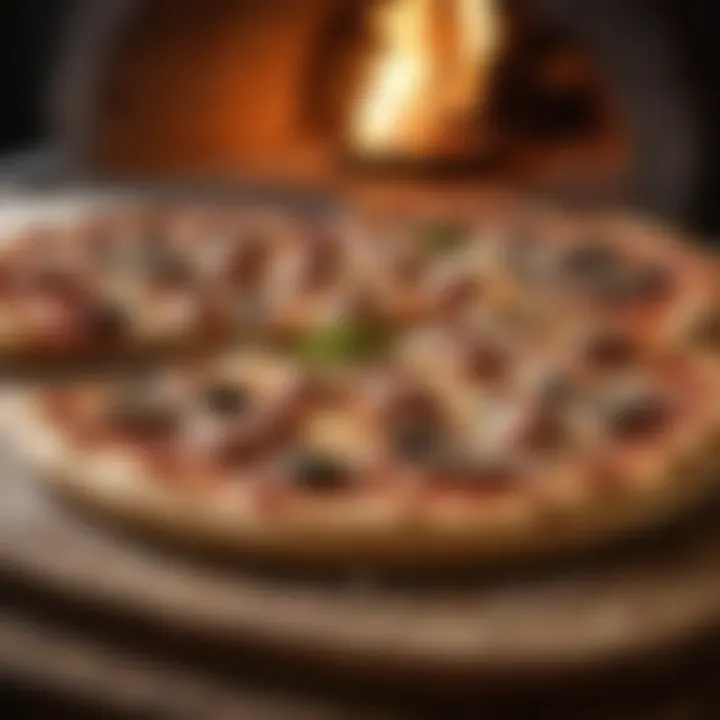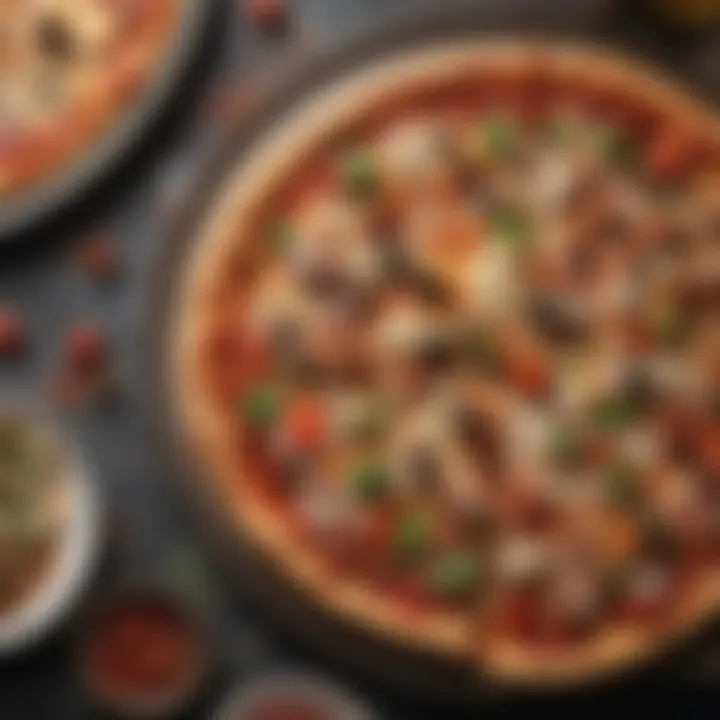Mastering the Art of Cooking with a Pizza Oven


Intro
Cooking with a pizza oven offers a unique and enriching experience, one that can elevate the simplest ingredients into extraordinary dishes. These ovens are designed to reach high temperatures, often exceeding 800 degrees Fahrenheit. This capability is pivotal in achieving that perfect pizza crust—a balance between a chewy interior and a crispy exterior.
Unlike conventional ovens, pizza ovens distribute heat more evenly and intensely. Understanding its operation is essential for maximizing one’s culinary potential. In this exploration, we will address key techniques, essential equipment, and a selection of savory recipes tailored for both the novice and the seasoned cook. As we dive into the details, the focus will remain on practical insights and recommendations for productive cooking sessions.
Embracing the art of using a pizza oven can lead to richer culinary experiences. We aim to inspire creativity and experimentation, while imparting knowledge on optimal cooking conditions and styles. Let's start by examining some of the fundamental recipes that harness the capabilities of a pizza oven.
Understanding Pizza Ovens
Understanding the unique characteristics and functionalities of pizza ovens is critical for anyone looking to enhance their cooking experience. Pizza ovens are not mere appliances; they are designed to create specific textures and flavors that are hard to achieve with conventional cooking methods. Knowing how these ovens work gives cooks valuable insight into temperature control, cooking times, and overall cooking techniques. This understanding opens up opportunities to experiment with a variety of dishes.
Types of Pizza Ovens
Wood-Fired Pizza Ovens
Wood-fired pizza ovens are often celebrated for their ability to reach high temperatures, which creates that classic char on the crust. One important aspect is the natural flavor imparted by burning wood. Many chefs and pizzeria owners consider this a major advantage for enhancing the taste profile of their pizzas.
However, these ovens require more maintenance. They need regular cleaning and specific types of wood for optimal performance. Despite these requirements, many still find wood-fired ovens to be a worthwhile investment, as they deliver a unique flavor that no other oven can replicate.
Gas Pizza Ovens
Gas pizza ovens provide a more consistent cooking experience. The temperature control system allows for precise adjustments, which can be quite beneficial when dealing with various recipes. This reliability makes gas ovens a popular choice among both home cooks and professionals.
However, a disadvantage is that they lack the smoky, robust flavor provided by wood-fired options. Gas ovens are also generally easier to clean and maintain than their wood counterparts, making them more user-friendly for daily use.
Electric Pizza Ovens
Electric pizza ovens are increasingly becoming a common choice among home bakers. Their primary benefit lies in their convenience and ease of use. They can be plugged into any outlet and are generally compact, fitting well in limited kitchen spaces. Ideal temperature settings can usually be set with just a dial.
One downside is that electric ovens may not achieve the same high temperatures as wood or gas ovens. This can impact the texture of the crust. Nevertheless, electric ovens provide a feasible alternative for those who prioritize simplicity and ease.
Portable Pizza Ovens
Portable pizza ovens are gaining popularity for their flexibility. These ovens are designed for outdoor use, making them suitable for camping, picnics, or backyards. They often use propane or charcoal, combining convenience with the ability to cook pizza at high temperatures.
A key feature of portable ovens is how easy they are to set up and take down, making them a great choice for casual gatherings. However, they sometimes come with a smaller cooking capacity, which might be a consideration for larger groups.
How Pizza Ovens Differ from Conventional Ovens
Temperature Control
Temperature control is crucial when it comes to pizza ovens. Unlike conventional ovens, which may rely more on ambient air circulation, pizza ovens can reach elevating temperatures quickly. High temperatures create a crispy crust while maintaining a moist interior.
This feature makes pizza ovens particularly beneficial for anyone serious about pizza making. However, the rapid heating can also lead to burnt foods if not monitored closely.
Cooking Time
Cooking time in a pizza oven is significantly less than in conventional ovens. A well-prepared pizza can cook in as little as 90 seconds when the oven is adequately preheated. This efficiency allows for a quick turnaround, making it easy to serve multiple pizzas in a single cooking session.
However, the faster cooking time requires skill in placing the pizza and monitoring progress, especially for layered toppings that take longer to cook.
Moisture Retention
Moisture retention is another area where pizza ovens show their strength. They often maintain a dry heat, which is essential for achieving that desired crispness on pizza crusts. This aspect helps prevent soggy bottoms, a common issue when cooking in conventional ovens.
Nonetheless, moisture retention can be a double-edged sword. If not managed properly, you can end up with pizzas that are too dry. Understanding this characteristic will enhance culinary outcomes, tailoring cooking methods to the specific needs of the dish.
Key Elements of Successful Pizza Cooking
Successful pizza cooking relies on several core elements that ensure a final product full of flavor and texture. This section emphasizes critical practices while preparing and cooking your pizza in a dedicated oven. Each aspect contributes significantly to achieving the ideal pizza outcome.


Preheating the Oven
Importance of Preheating
Preheating the oven is foundational in cooking pizza. An adequately preheated oven allows for the crust to form quickly, creating a desirable texture. This rapid heat exposure also contributes to moisture retention in the dough, preventing it from becoming soggy. When the oven reaches the appropriate temperature, the cooking environment becomes optimized for a balanced bake.
This characteristic of preheating is crucial. It aids in achieving that perfect crust which is the hallmark of a great pizza. The preheated pizza oven can reach temperatures of up to 900 degrees Fahrenheit, significantly higher than conventional ovens. Consequently, this characteristic makes it a preferred tool for pizza lovers.
Optimal Temperature Ranges
Understanding optimal temperature ranges is key to successful pizza cooking. For wood-fired ovens, the typical range is between 800 to 900 degrees Fahrenheit. Gas and electric pizza ovens usually perform best between 475 to 575 degrees. This temperature range allows for perfectly cooked pizza toppings while ensuring the crust remains crisp.
The key characteristic of these specific temperature ranges is their ability to rapidly cook the pizza, which is essential for achieving a ventilated crust. However, caution must be exercised at higher temperatures, as they can also lead to burning if not monitored closely. This balance is a necessary component of the successful pizza-cooking equation.
Choosing the Right Pizza Stone
Material Considerations
Selecting the right pizza stone is essential for achieving authentic cooking results. Different materials, such as cordierite or ceramic, can influence the heat retention and transfer during cooking. Cordierite stones are popular due to their durability and excellent heat distribution properties. This material can handle high temperatures without cracking and is easy to maintain.
Conversely, ceramic stones tend to result in a slower heat transfer but can provide a different flavor profile. This material is often preferred by traditionalists who favor the aromas that arise from clay-based cooking. Each option has unique features and associated benefits, which should be considered when investing in a pizza stone.
Thickness and Size
The thickness and size of a pizza stone are crucial aspects that affect cooking performance. A thicker stone absorbs heat better and provides a more stable cooking surface, helping to ensure even crust cooking. Ideal thickness typically ranges from 0.5 to 1 inch.
Size matters in accommodating various pizza types. A larger stone allows for greater culinary creativity with different sizes and styles of pizzas. Additionally, ensuring it fits perfectly within your oven is critical. Choosing the right thickness and size achieves the advantageous balance between heat retention and convenience in handling.
"Mastery of these elements leads to remarkable pizza experiences, transforming simple ingredients into culinary masterpieces."
By focusing on these key elements, individuals can refine their pizza-making skills. Preheating the oven properly and selecting the right materials for the pizza stone will enhance the overall cooking experience. Each choice made during this process contributes not only to taste but also to the overall enjoyment of pizza cooking.
Essential Cooking Techniques
Essential cooking techniques form the bedrock of effective pizza preparation. Understanding these techniques can enhance flavor, texture, and presentation. Each component, from dough preparation to baking, contributes significantly to the overall quality of the pizza. Mastering these elements is prime for unleashing the full potential of a pizza oven.
Dough Preparation
Proper dough preparation is crucial as it determines the base characteristics of the final product. It encompasses the selection of flour, kneading methods, and fermentation processes. Each step influences how the dough rises and develops its flavor.
Choosing the Right Flour
When selecting flour, it is important to consider protein content. High-protein flours help create a strong gluten network. This is necessary for holding air during fermentation. All-purpose flour is versatile; however, 00 flour is often favored for its fine texture and high protein content. This characteristic allows for a chewier crust, essential for authentic Neapolitan-style pizza. The unique feature of quality flour is its ability to absorb water better, resulting in a dough that is easier to work with. A disadvantage may be a higher cost compared to standard flours.
Kneading Techniques
Kneading is an essential part of developing gluten in the dough. It strengthens the gluten, providing the necessary elasticity. A common method involves the use of the stretch and fold technique. This method allows the dough to aerate without overworking it. Kneading properly ensures a well-structured dough, essential for good oven spring. One disadvantage might be that improper kneading can lead to a tough texture.
Fermentation and Rising
Fermentation affects flavor development and texture. Longer fermentation times often yield complex flavors due to the breakdown of sugars by yeast. A popular choice among bakers is a cold fermentation method. This slow process enhances the crust's flavor significantly. However, a longer waiting time is required. The advantage is a more flavorful crust. On the downside, it requires foresight and planning.
Sauce and Topping Selection
Choosing the right sauce and toppings elevates a pizza's taste and appeal. What you decide can significantly affect how the pizza is received.
Traditional Tomato Sauce
Traditional tomato sauce is essential for many classic pizzas. It typically includes crushed tomatoes, olive oil, and seasonings like salt and oregano. The key characteristic of this sauce is its bright flavor, which complements various toppings. It provides a moist element that enhances the overall texture. The unique feature lies in its versatility; this sauce can adapt with many flavor profiles. However, it might not appeal to those desiring a lower-acid option.
Alternative Sauces


Usage of alternative sauces can introduce exciting new flavors. Options such as pesto or white sauces offer different profiles compared to traditional sauces. These alternatives often cater to diverse dietary preferences. The advantage of these sauces is their ability to enhance creativity in pizza-making. A disadvantage is that they might not align with traditional pizza expectations, potentially not appealing to all.
Toppings Combinations
Topping combinations can transform a basic pizza into a unique culinary creation. Each ingredient must harmonize with the others to ensure a balanced flavor. Popular pairing such as pepperoni with mozzarella is timeless. Using fresh ingredients enhances taste and offers a wholesome texture. The key characteristic of thoughtful toppings is the emphasis on contrast and harmony. A poor selection may lead to overpowering flavors or textural inconsistencies.
Baking Process
The baking process is pivotal for achieving the desired final product. Several factors must be considered to optimize the outcome.
Positioning the Pizza
Positioning the pizza correctly in the oven can significantly influence cooking results. A common practice is to place the pizza on the upper third of the oven to get a crispy crust. This method allows even heat distribution. The advantage here is a well-baked pie with a crust that is crispy outside and soft inside. An inconvenience may be needing to frequently open the oven door to reposition.
Monitoring Cooking Progress
Monitoring cooking progress is essential for achieving specific textures and doneness levels. Checking the pizza every few minutes can reveal if it is cooking unevenly. Signs to look for include bubbling cheese and a golden crust. This key characteristic of attentiveness can help in adjusting heat or rotation actions. Neglecting this could result in a burnt or undercooked pizza.
Finishing Techniques
The finishing techniques involve adding the final touches post-baking. This may include drizzling olive oil or fresh herbs. Adding these elements enhances the presentation and flavor profile. The unique feature of finishing touches is their ability to elevate the dish without much effort. However, excessive toppings might overshadow the flavors of the pizza itself.
Exploring Beyond Pizza
Cooking with a pizza oven is often associated with its primary use: crafting the perfect pie. However, these ovens have remarkable versatility that can enhance many culinary experiences. Exploring beyond just pizza allows cooks to discover a range of flavors and techniques. Dishes like rustic breads, roasted vegetables, and grilled meats can take advantage of the high heat and unique cooking environment of pizza ovens.
Understanding the importance of this exploration is vital. It opens avenues for creativity and innovation in cooking. This section will showcase various ingredients, correct techniques, and how they utilize the strengths of a pizza oven.
Baking Bread
Baking bread in a pizza oven is an ancient practice that retains its charm to this day. The key benefit of using a pizza oven is its capability to reach high temperatures which results in a crust that is crispy and golden.
Types of Bread Suited for Pizza Ovens
Not all breads can thrive in a pizza oven. Sourdough, ciabatta, and focaccia are notable examples that perform well. The high temperatures of a pizza oven allow these types to develop a robust crust while keeping the inside tender and airy. Sourdough is particularly popular; its natural fermentation complements the unique heat environment. The fast cooking time also means that moisture is sealed in quickly, resulting in enhanced flavor.
Some breads may not fare as well. Delicate pastries can burn while crusty loaves may demand careful monitoring. This aspect emphasizes the importance of knowing which types of bread to use for satisfactory results.
Baking Techniques for Bread
Baking techniques in a pizza oven follow a few general principles. Preheating the oven is essential to create a stable environment for baking. Using a baking stone is also highly recommended; it ensures an even heat transfer. Steam can be introduced at the start of baking to help achieve a crusty exterior, enhancing the bread's overall quality.
A unique feature is the need for shorter baking times, which can be beneficial for quick bread making. There’s a challenge that comes with this efficiency; it requires precision. Overcooked bread may result in a harsh texture and taste.
Roasting Vegetables
Roasting vegetables in a pizza oven can lead to vibrant flavors enhanced by smokiness. This method is especially useful for those who enjoy seasonal produce. The high heat of the oven caramelizes natural sugars, bringing out deeper flavors.
Preparation and Seasoning
Proper preparation and seasoning are crucial for roasting vegetables in a pizza oven. Cutting them into uniform pieces ensures that they cook evenly. Olive oil, salt, and herbs are popular choices. These ingredients not only elevate the taste but also contribute to the caramelization process. A unique aspect is that vegetables may need little more than a few minutes to become tender and delicious. The high intensity of heat can be a double-edged sword; if left unattended, they may burn quickly.
Cooking Climate Inside a Pizza Oven
The cooking climate inside a pizza oven is distinct. Its high, direct heat creates an environment that can transform dishes rapidly. This makes it perfect for roasting vegetables. The rapid air movement helps in keeping vegetables dried out, while still achieving that crispy texture. Adjusting the temperature can influence the cooking outcome. Too hot, and vegetables can char; too cool, and they may lose flavor.
Grilling Meats
Grilling meats in a pizza oven can yield impressive results. The high heat creates a good sear on the outside while allowing for even cooking on the inside. The versatility of various meats being cooked all at once is a notable advantage.
Best Practices for Grilling


When grilling, one should consider several best practices. Marinating the meat beforehand enhances flavor and tenderness. Ensuring that the oven is properly preheated is vital for achieving the desired texture. Using a two-zone setup can be useful to manage different cooking times for various cuts. Additionally, monitoring the meat with a thermometer can avoid overcooking. The unique aspect of this practice is that timing is crucial, yet results can vary widely.
Cooking Times for Different Meats
Cooking times for different meats differ greatly depending on the cut and type. For example, chicken may need 20-30 minutes while beef steak might only require 7-10 minutes. High temperatures can cook meats surprisingly fast, which highlights the balance between temperature and timing. Care is needed to ensure meats reach proper internal temperatures for safety. A quick reference chart may assist in this area:
- Chicken: 165°F (20-30 min)
- Steak: 145°F (7-10 min) for medium rare
- Pork: 145°F (10-15 min)
Maintaining Your Pizza Oven
Maintaining your pizza oven is crucial for ensuring optimal cooking performance and longevity. A well-maintained oven not only enhances the quality of your cooking but also improves safety. Regular maintenance prevents issues like uneven cooking, smoke emission, and eventual damage to the oven itself. Therefore, it is essential to establish a routine that includes thorough cleaning and seasonal checks. This will help you enjoy the full benefits of your pizza oven, whether you are an occasional user or a dedicated enthusiast.
Cleaning After Use
Debris Removal
Debris removal after cooking is a foundational aspect of maintaining a pizza oven. When you cook, small particles from dough, toppings, or even ash from a wood-fired oven can accumulate. Removing this debris helps prevent buildup that can lead to unwanted flavors in future meals.
The key characteristic of debris removal is its simplicity. This step is often quick and requires minimal tools such as a brush and scraper. Regular cleaning prevents long-term damage, making it a beneficial choice for maintaining an effective cooking environment.
Advantages include easier future cleanups and the reduction of fire hazards in wood-fired models. However, over-reduction of debris to the point of scraping the stones too harshly can cause damage, so it is crucial to use appropriate tools and techniques.
Stone Care
Taking care of the pizza stone itself is another critical aspect of maintaining your oven. The stone absorbs heat and retains moisture while cooking, which directly influences the quality of the crust and overall pizza. Proper care involves allowing the stone to cool before cleaning and using mild soap, if necessary.
The key feature of stone care is preventing cracking and degradation. This involves inspecting the stone regularly for cracks or discoloration. Good stone care contributes to enhanced cooking results, making it a popular maintenance practice among pizza enthusiasts.
A unique feature of stone care is its impact on flavor. A well-maintained stone ensures that flavors from previous cooks do not linger and affect new dishes. However, excessive moisture or oil can cause the stone to become less effective over time, so balancing care is essential.
Seasonal Maintenance Considerations
Checking for Wear and Tear
Periodic checks for wear and tear are necessary for long-term usability of your pizza oven. This involves evaluating the physical state of the oven, including the door hinges, insulation, and any added features such as thermometers. Spotting signs of wear allows for timely repairs and prevents larger issues that can come from neglect. The benefit of this practice lies in its preventative nature. Addressing minor issues can save time and money in the long run. Maintenance of this sort includes reinforcing any weak spots to ensure that the oven operates at its best.
A unique characteristic of this process is that it often requires only a few minutes of your time every few months. However, casual neglect can lead to expensive repairs, so regular checks are essential.
Protecting Against the Elements
Protecting your pizza oven from the elements is vital, especially if it is located outdoors. Rain, snow, and fluctuating temperatures can affect both the physical structure and the operational mechanics of an oven. Using a cover or storing the oven in a dry place can drastically prolong its lifespan and maintain cooking efficiency. The key aspect of protecting against the elements is to ensure consistent performance. Weatherproofing reduces the likelihood of rust and degradation of materials. This choice is particularly beneficial for outdoor ovens that face harsh climates.
A unique feature of this aspect is that it can be easily integrated into regular usage routines. However, choosing the wrong type of cover or failing to secure it properly can lead to more trouble than benefits, so it’s important to select appropriate materials and designs.
Final Thoughts on Pizza Ovens
Pizza ovens represent an evolution in home cooking that transcends the ordinary. Through this exploration, we have witnessed how these ovens enhance both the cooking experience and the quality of food produced. The unique heat distribution, high temperatures, and versatility provide a platform for culinary creativity that traditional ovens often cannot offer. Whether you are a novice or an experienced cook, understanding the nuances of a pizza oven can elevate your cooking to new heights.
The importance of discussing the future of pizza cooking lies in its ability to keep pace with culinary trends and technological advancements. As we delve into the evolving landscape of pizza cooking, we consider emerging styles and the integration of modern technology into traditional practices. This offers valuable insights into how pizza ovens can continue to inspire both new and seasoned chefs.
Future of Pizza Cooking
Culinary Trends
Culinary trends are always in motion, and pizza cooking is no exception. Today, there is a shift towards healthier options and innovative ingredients. This aspect matures the pizza-making experience. The emphasis on artisanal methods, using organic ingredients, is now prevalent. As a result, one observes a growth in the popularity of alternative crusts, such as cauliflower or whole wheat. These trends appeal to health-conscious consumers seeking flavorful yet nutritious meals.
A key characteristic of culinary trends in pizza cooking is the revival of traditional techniques. For instance, sourdough crusts and homemade sauces are gaining attention. These ingredients not only offer complexity in flavor but also allow for flexible dietary options. They represent a pivotal approach to pizza-making, aligning with the growing focus on sustainability and authenticity, which is beneficial both for the consumer and the environment.
The unique feature of these trends is their adaptability. From outdoor gatherings to gourmet restaurants, these innovative practices enhance the overall dining experience. However, the drawback may be the time investment required in creating artisanal pizzas. This may deter some novice cooks but inspires a deeper appreciation for the craft.
Technological Advancements in Pizza Ovens
Technology plays a critical role in shaping the future of pizza ovens. The emergence of smart pizza ovens is a prominent development that allows for greater precision in cooking. Features like automated temperature control and timers enable users to achieve optimal results without constant monitoring. This advancement significantly simplifies the cooking process.
A key characteristic of these technological innovations is their ability to replicate the effects of traditional wood-fired ovens. For example, some ovens use specialized heating elements that mimic the radiant heat necessary for a perfect pizza. This makes advanced pizza ovens a popular choice for home cooks looking to replicate restaurant-quality results.
The unique feature of smart pizza ovens is their connectivity. Some models offer mobile apps to provide guidance on temperature and cooking times, as well as access to a range of recipes. While these innovations offer convenience and consistency, they may come at a higher price point. This can be a consideration for those on a budget, yet the investment can be justified by the operational ease and superior results.
"Embracing both culinary trends and technological advancements empowers cooks to elevate their pizza-making journey."
In summary, as we reflect upon the future of pizza cooking, we can appreciate the blend of tradition and innovation. By understanding these movements, one can enrich the pizza experience, appreciating the journey from dough preparation to the last slice served.







